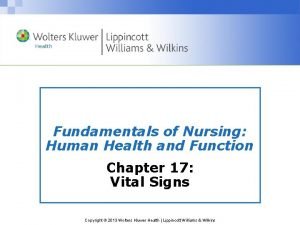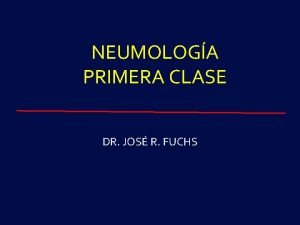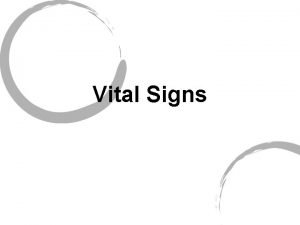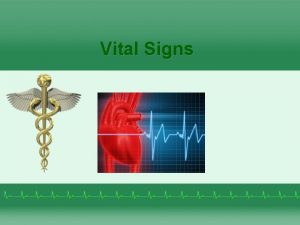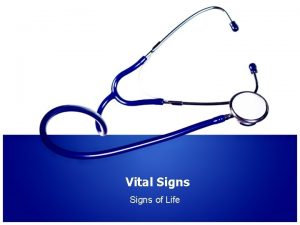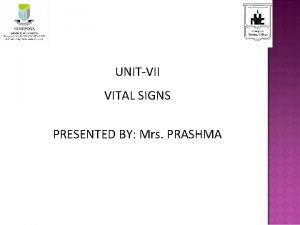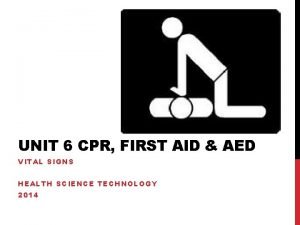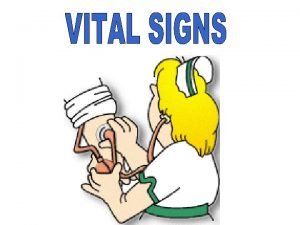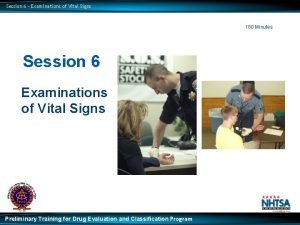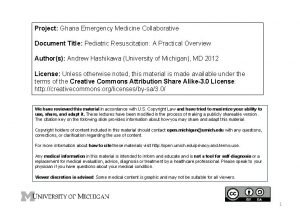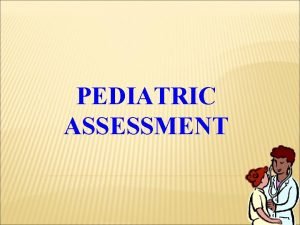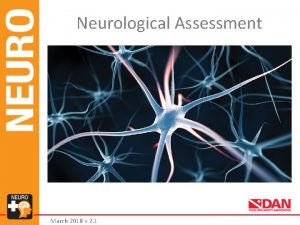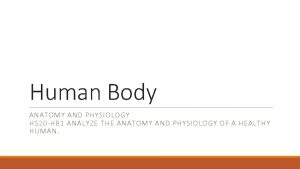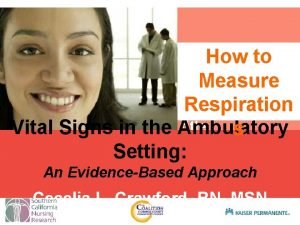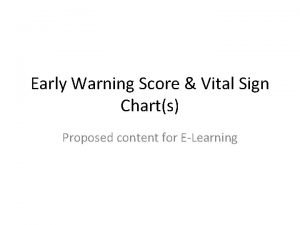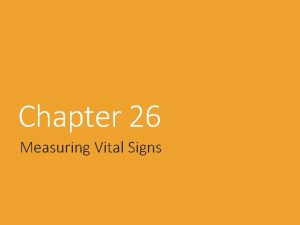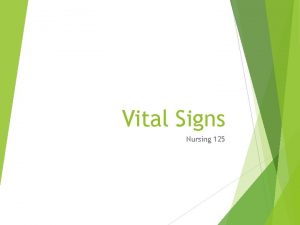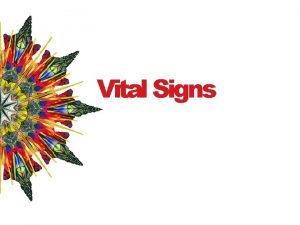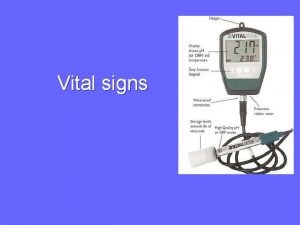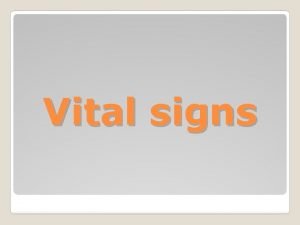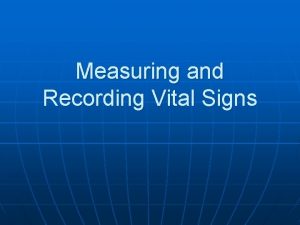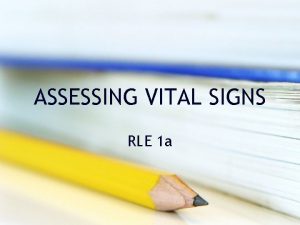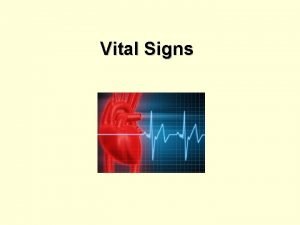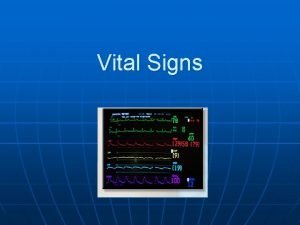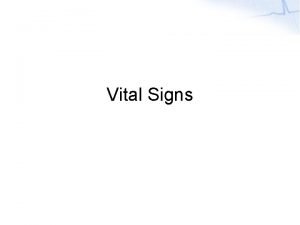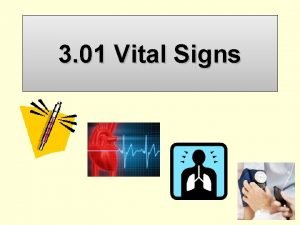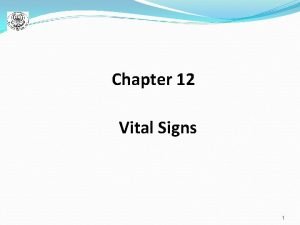Vital Signs Fundamentals Unit 5 Vital Signs Temperature





























- Slides: 29

Vital Signs Fundamentals Unit 5

Vital Signs- Temperature o Temperature terms: n Afebrile-not having elevated temperature n Cardinal symptoms- Vital Signs n Febrile- having as elevated body temperature n Hypothermia- decreased body temperature n Hyperthermia- elevated body temperature

Vital Signs n Body temperature is a balance between heat lost and heat produced, controlled by the hypothalamus n What influences temperature? o Age o Time of day o Exercise o Hormones o Stress o Environment o Illness

Vital Signs o Sx of high temperature include… n n n Flushed Glassy eyes Rapid breathing and heart rate Unusual thirst, anorexia, nausea Changes in mental status o Sx of subnormal temperature include… n Pale n Cold n Clammy

Vital Signs o An abnormally high or low temperature is a medical emergency o Normal body temperature is 98. 6 degrees Fahrenheit or 37 degrees Centigrade (Celsius). o A normal range is about 1 degree above or below a Fahrenheit reading or 0. 5 degrees above or below a Centigrade reading

Vital Signs o Celsius (Centigrade) vs. Fahrenheit o Conversion Formulas n Celsius = F – 32 x 5/9 OR Celsius = F – 32 / 1. 8 n Fahrenheit = C x 9/5 + 32 OR Fahrenheit = 1. 8 x C + 32

Vital Signs o Thermometer o The oldstyle mercury thermometer o Taking the temperature…some general rules n Oral n Rectal n Axillary

Vital Signs o There are different characteristics for each site you’d take a temperature… n Oral-keep mouth closed n Rectal-longer time for accurate measurement n Axillary- longest period of time n Tympanic- registers in less than 2 seconds n Temporal-infared, measures temperature of temporal artery

Vital Signs-Pulse o The 3 pulse assessments n Rate- 60 -100 Ø Tachycardia-greater than 100 beats per minute Ø Bradycardia-less than 60 beats a minute n Rhythm- regular or irregular Ø Dysrhythmia=irregular pulse n Quality (Volume)- amount of blood pushing against artery

Vital Signs o What factors influence pulse rate? o Age-decreases birth to adulthood o Activity and position- exercise and laying down = lower heart rate o Gender- males are lower o Body temperature- increase=increase o Blood volume and circulating components-decrease volume, increase rate o Stress, emotion, pain-increase rate o Drugs

Vital Signs o What factors influence pulse? n When I feel the rhythm…(spacing of beats) n When I note the quality/volume… (strength of beats) o Normal o Thready or Weak-difficult to feel o Full or bounding- strong even with pressure n What is a doppler?

Vital Signs Where can I feel pulses at?

Vital Signs o Which sites are best used for… n n An emergency- Carotid Convenience- Radial Most accurate- Apical Circulation assessment- Dorsalis Pedis

Vital Signs o Assessing the Radial Pulse o Assessing the Apical Pulse n The heart sounds… n Let’s look at the stethoscope… o Assessing an Apical/Radial Pulse n Pulse Deficit-difference between Apical and Radial Pulses

Vital Signs-Respirations o Did you know there are 2 parts to 1 respiration? n Inspiration-chest rise, lungs expand n Expiration- chest decreases, air forced out o Organs of respiration- lungs, chest muscles, diaphragm o Did you know there are 2 types of respiration? n External-use of lungs for gas exchange n Internal- exchange of gases between the blood and tissue cells

Vital Signs o The respiratory center is located in the brain and stimulated by CO 2 o Respirations increase or decrease in direct relationship with the CO 2 in the blood.

Vital Signs o We need to consider several factors with our respiratory assessment. n n Rate-influenced by many factors Rhythm- regular or irregular Depth- chest movement seen or felt Quality- chest movement, skin color, noise, symmetry, restlessness, disorientation

Vital Signs o What influences each of these factors? n n n n Age- faster when younger in age Disease- chronic or acute Gender- females slightly faster Exercise-increase activity, increase rate Body position- affects depth Stress- increase rate and depth Drugs- depressants=depress, stimulants=increse o Assessing respirations…

Vital Signs-Blood Pressure o Let’s talk about terms and equipment. n Blood pressure- measure of blood against the walls of arteries n Hypertension- Elevated blood pressure n Hypotension- Low blood pressure n Sphygmomanometer- instrument for measuring blood pressure n Pulse pressure-Difference between Systolic and Diastolic readings n Korotkoff’s sounds- "tapping" sounds heard with a stethoscope as the cuff is gradually deflated.

Vital Signs q Systolic Pressure- the upper number § The pressure present when the left ventricle of the heart contracts and forces blood to the arteries. q Diastolic Pressure- the lower number § The relaxation of the left ventricle allowing blood to refill

Vital Signs o Types of sphygmomanometers n Mercury n Aneroid n Electronic o The brachial artery is most commonly used o Site contraindications are… n n n IV fluids are infusing Shunt Cast or bulky dressing Trauma or paralysis Side of breast or axillary surgery

Vital Signs o Where is the brachial artery? o Assessing the blood pressure… n Systolic and diastolic n The standard of measurement is millimeters of mercury or mm. Hg

Vital Signs o Heart Rate x Stroke Volume = Cardiac Output (reflected in systolic reading) o Peripheral vascular resistance is reflected in the diastolic reading o MAP = systolic + (2 x diastolic) 3

Vital Signs o Some factors influence blood pressure… n Circulating blood volume-increase volume, increase pressure n Age- younger=lower n Exercise-increases blood pressure n Time of day-lower BP earlier in the day n Sex-females have lower n Stress, anxiety, fear, pain-raise BP n Medications-antihistamines, steroids, caffeine, nicotine n Race- Caucasian males have lower BP n Cardiac disease- n Obesity-Higher BP

Vital Signs o How do I take a blood pressure? o How do I document the blood pressure, and the other vital signs? o Practice your vital signs assessment in total.

Vital Signs. Terms to know o o o Height-ht Inch-in or “ Centimeter-cm Foot-ft Meter-m o o o Weight- wt Ounce- oz Pound- lb Kilogram-kg Gram- g

Vital Signs o Types of scales n n n Bed scale Standing scale Wheelchair scales Bariatric scales Pediatric scales

Vital Signs o Why do daily weights? n Fluid balance indicator n Calculating medications n Nutritional status o Rules for daily weights n n Same scale Same time Same clothing Same bed linens and pillows (if bed scale)

Vital Signs o Important conversions n n 2. 2 pounds=1 kilogram 1000 grams=1 kilogram 12 inches=1 foot 2. 5 centimeter= inch
 Chapter 17 fundamentals of nursing
Chapter 17 fundamentals of nursing What are the 8 vital signs?
What are the 8 vital signs? Summary of vital signs
Summary of vital signs Sign sign everywhere a sign
Sign sign everywhere a sign Unit 14:1 measuring and recording vital signs
Unit 14:1 measuring and recording vital signs Capacidad vital y capacidad vital forzada
Capacidad vital y capacidad vital forzada Difference between curie temperature and neel temperature
Difference between curie temperature and neel temperature Difference between curie temperature and neel temperature
Difference between curie temperature and neel temperature Ferromagneti
Ferromagneti Vital signs definition
Vital signs definition Vital signs normal rate
Vital signs normal rate Respiration as a vital sign
Respiration as a vital sign Normal respiratory rate
Normal respiratory rate C
C What are the 8 vital signs?
What are the 8 vital signs? Baseline vital signs
Baseline vital signs Respiratory rate normal
Respiratory rate normal Conclusion on vital signs
Conclusion on vital signs Vital signs cpr
Vital signs cpr Average adult respirations
Average adult respirations 6 vital signs
6 vital signs Wikimedia
Wikimedia Deep tendon reflex
Deep tendon reflex Peds vital signs
Peds vital signs Orthostatic vital signs
Orthostatic vital signs Orthostatic vital signs
Orthostatic vital signs Neuro vital signs meaning
Neuro vital signs meaning Normal vital sign ranges
Normal vital sign ranges Normal respiratory rate
Normal respiratory rate Cewt chart 5-11
Cewt chart 5-11
